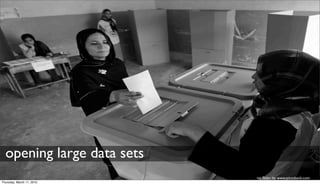Opening Large Data Sets
- 1. opening large data sets via ïŽickr: by www.pictobank.com Thursday, March 11, 2010
- 3. Data Sources: âĒ Original Polling Center Master list of 6,969 polling centers from the Independent Election Commission (IEC). âĒ IEC's election prelim results from September 16th, a 2,500 page PDF. âĒ The Electoral Complaints Commission's (ECC) complaint data (which aggregates only to the provincial level). twitter.com/ericg Thursday, March 11, 2010
- 4. we needed a data browser Thursday, March 11, 2010
- 6. Thursday, March 11, 2010
- 7. The system geo codes votes down the the district level. The political boundaries for this map covered 400 districts. Density point visualization shows results based on the Highlighted stations criteria, in this case % of stations effected. Thursday, March 11, 2010
- 8. Complex analysis: This Afghan ethnic distribution base layer is overlaid with districts won by Karzai (red dots) and Abdullah (green dots). Dot size indicates the number of votes. Ethnic data is digitized from the Soviet Atlas Narodov Mira Thursday, March 11, 2010
- 9. Interacting with the data: you can quickly drill down to any region, as the map zooms. Thursday, March 11, 2010
- 10. âĒ Percent Population Urban by District Population by District (2003-2004) AIMS CSO Population Statistics. âĒ Settled Population by Province (2006-2007) Afghanistan Human Development Report 2007, Center for Policy and Human Development, Kabul University âĒ Estimated votes, via IECâs Master Polling Center list Thursday, March 11, 2010
- 11. Population: 22,700 Estimated voters: 53,039 Difference: 30,339 Thursday, March 11, 2010
- 12. Total votes: 15,023 Thursday, March 11, 2010
- 13. Drill down in context: âHighlighted Stationâ selection continues to work within both provinces + districts Thursday, March 11, 2010
- 14. Per polling center data: see the affected stations and votes within a polling center Thursday, March 11, 2010
- 15. Thursday, March 11, 2010
- 16. Thursday, March 11, 2010
- 17. Thursday, March 11, 2010
- 18. security matters photo credit boston.com Thursday, March 11, 2010
- 19. Thursday, March 11, 2010
- 20. Thursday, March 11, 2010
- 21. geography matters via ïŽickr: by www.pictobank.com Thursday, March 11, 2010
- 22. Thursday, March 11, 2010
- 23. Thursday, March 11, 2010
- 24. Road data: OSM provides better street data than AIMS Thursday, March 11, 2010
- 25. Thursday, March 11, 2010
- 26. twitter.com/ericg via wikimedia.org Thursday, March 11, 2010
- 27. Thursday, March 11, 2010
- 28. Snow line: 1,800 meters according to FAO Thursday, March 11, 2010
- 29. Thursday, March 11, 2010
- 30. Map Data Sources: âĒ Elevation information is from the SRTM (Shuttle Radar Topography Mission) âĒ Road information from OpenStreetMap âĒ Provincial and district data are from AIMS (Afghanistan Information Management Services) Thursday, March 11, 2010






























